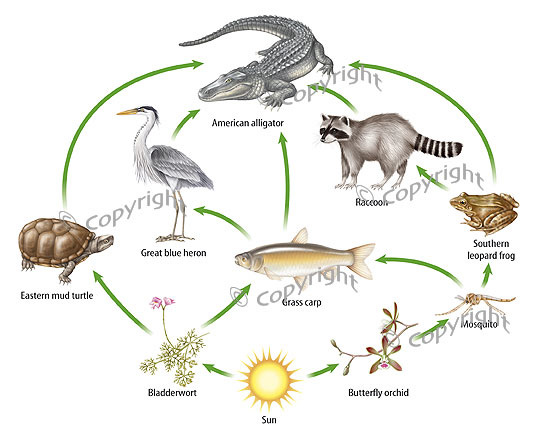Plants are called _________ because they make their own food.
Producers
Some animals that used to live in the Everglades in great numbers are now endangered or _____________ .
A. Extinct
B. Thriving
C. Threatened
D. Gone
A. Extinct
____________ is an organism that produces organic compounds from simple substances such as water and carbon dioxide
Producer
As human population grows, what happens to the supply of natural resources?
It decreases
True or False: Producers are at the bottom level of both the energy pyramid and the biomass pyramid.
True!
One food chain in an ecosystem might be grass, a mouse, a snake and a hawk. Which one is the producer?
A food web is a cycle because it transfers _____ from one organism to another.
A. A chain
B. A web
C. Energy
D. Nothing
C. Energy
Organisms that feed either directly or indirectly on producers are _____________.
Consumers
What were some reasons that areas have larger population sizes?
Good climate, close to oceans
Complete burning of plant material returns carbon primarily to the _____________.
Atmosphere
Which of these organisms would most likely be found at the top of an energy pyramid?
A. clams - a primary consumer
B. sardines - a primary consumer
C. sharks - a secondary consumer
D. kelp - a primary producer
C. sharks- a secondary consumer
What is the invasive species of the Everglades that we discussed during our food web activity?
Burmese Python
____________________________ are organisms that break down dead matter in an ecosystem.
Detritivores
___________ is defined as being all the inhabitants of a particular town, area, or country.
Population
True or False: Decomposers absorb carbon from the atmosphere, so if they were removed more carbon would reach the atmosphere.
False! Decomposers RELEASE carbon into the atmosphere, so if they were removed LESS carbon would reach the atmosphere.
The diagram below shows the cycling of nutrients in an ecosystem.
The removal of which of the following groups would cause an immediate decrease in the amount of energy flowing through the system?
Producers
Within this food chain, grass→ grasshopper → frog → snake, which organism would we expect to have the lowest population?
Snake
During the human footprint activity, what did places with less human impact have in common?
Inhabitable, harsh climates
Which of the following is one of the four factors that scientists looked at when building the maps we studied?
A. Travel routes
B. Water quality
C. Clouds
D. Food consumption
A. Travel routes
In a process called transpiration, plants get rid of excess water through pores in the leaves called stomata. This excess water is then released into the atmosphere as part of the water cycle. Which of the following terms best describes how the released water enters the atmosphere?
A. condensation
B. precipitation
C. evaporation
D. capillary action
C. evaporation
A diagram of a food web is shown below.
Which organism receives the least amount of energy from the producers?
Hawk

According to this food web, what organisms would be affected if the Great blue heron were to go extinct?
American alligator and Grass carp
____________________________________ is a chemical process within cells where sugar and oxygen react to form carbon dioxide and water resulting in the release of energy.
Photosynthesis
A new highly nutritious crop is going to be planted in an area where it has never been planted before. Which is the most likely outcome of such an event?
A. Negative
B. Positive
A. negative as it threatens biodiversity
The framework of organic molecules essential to all organisms is composed mainly of carbon atoms. What processes are involved in the cycling of carbon within an environment?
Photosynthesis and Respiration

